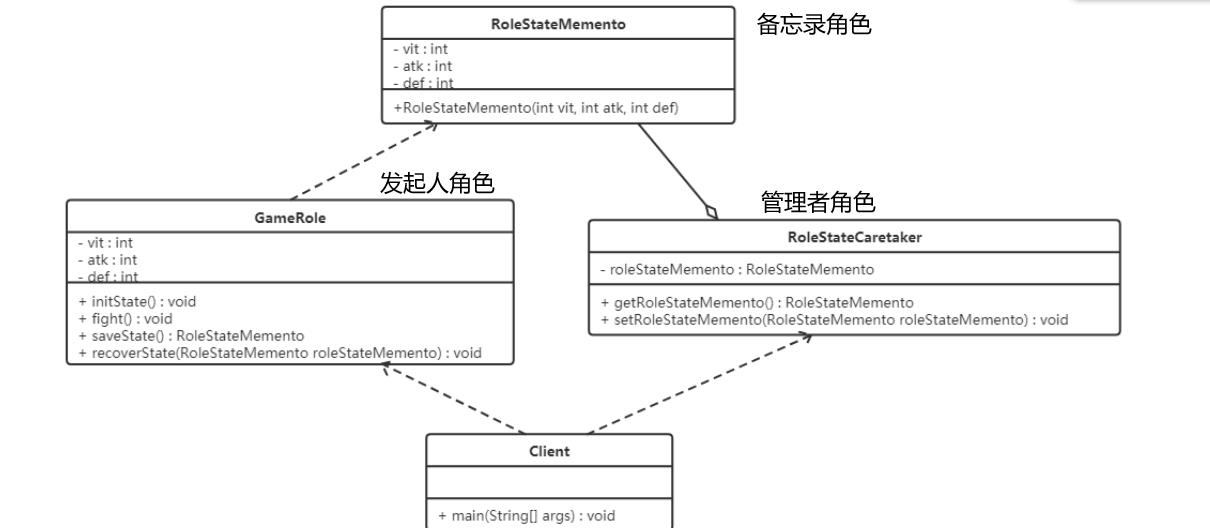设计模式 行为型模式 -- 备忘录模式 具体实例:游戏挑战BOSS
Posted CodeJiao
tags:
篇首语:本文由小常识网(cha138.com)小编为大家整理,主要介绍了设计模式 行为型模式 -- 备忘录模式 具体实例:游戏挑战BOSS相关的知识,希望对你有一定的参考价值。
设计模式 行为型模式 – 备忘录模式(定义、结构、优缺点 适用场景分析)
1. 备忘录模式 具体实例:游戏挑战BOSS
游戏中的某个场景,一游戏角色有生命力、攻击力、防御力等数据,在打Boss前和后一定会不一样的,我们允许玩家如果感觉与Boss决斗的效果不理想可以让游戏恢复到决斗之前的状态。
要实现上述案例,有两种方式:
- “白箱”备忘录模式
- “黑箱”备忘录模式
1.1 “白箱”备忘录模式(不推荐 破坏封装性)
备忘录角色对任何对象都提供一个接口,即宽接口,备忘录角色的内部所存储的状态就对所有对象公开。类图如下:

代码实现:

GameRole.java
package com.tian.memento.white_box;
/**
* @version v1.0
* @ClassName: GameRole
* @Description: 游戏角色类(属于发起人角色)
*/
public class GameRole {
private int vit; //生命力
private int atk; //攻击力
private int def; //防御力
//初始化内部状态
public void initState() {
this.vit = 100;
this.atk = 100;
this.def = 100;
}
//战斗
public void fight() {
this.vit = 0;
this.atk = 0;
this.def = 0;
}
//保存角色状态功能
public RoleStateMemento saveState() {
return new RoleStateMemento(vit, atk, def);
}
//恢复角色状态
public void recoverState(RoleStateMemento roleStateMemento) {
//将备忘录对象中存储的状态赋值给当前对象的成员
this.vit = roleStateMemento.getVit();
this.atk = roleStateMemento.getAtk();
this.def = roleStateMemento.getDef();
}
//展示状态功能
public void stateDisplay() {
System.out.println("角色生命力:" + vit);
System.out.println("角色攻击力:" + atk);
System.out.println("角色防御力:" + def);
}
public int getVit() {
return vit;
}
public void setVit(int vit) {
this.vit = vit;
}
public int getAtk() {
return atk;
}
public void setAtk(int atk) {
this.atk = atk;
}
public int getDef() {
return def;
}
public void setDef(int def) {
this.def = def;
}
}
RoleStateMemento.java
package com.tian.memento.white_box;
/**
* @version v1.0
* @ClassName: RoleStateMemento
* @Description: 备忘录角色类
*/
public class RoleStateMemento {
private int vit; //生命力
private int atk; //攻击力
private int def; //防御力
public RoleStateMemento(int vit, int atk, int def) {
this.vit = vit;
this.atk = atk;
this.def = def;
}
public RoleStateMemento() {
}
public int getVit() {
return vit;
}
public void setVit(int vit) {
this.vit = vit;
}
public int getAtk() {
return atk;
}
public void setAtk(int atk) {
this.atk = atk;
}
public int getDef() {
return def;
}
public void setDef(int def) {
this.def = def;
}
}
RoleStateCaretaker.java
package com.tian.memento.white_box;
/**
* @version v1.0
* @ClassName: RoleStateCaretaker
* @Description: 备忘录对象管理对象
*/
public class RoleStateCaretaker {
//声明RoleStateMemento类型的变量
private RoleStateMemento roleStateMemento;
public RoleStateMemento getRoleStateMemento() {
return roleStateMemento;
}
public void setRoleStateMemento(RoleStateMemento roleStateMemento) {
this.roleStateMemento = roleStateMemento;
}
}
Client.java
package com.tian.memento.white_box;
/**
* @version v1.0
* @ClassName: Client
* @Description: 客户端类:测试类
*/
public class Client {
public static void main(String[] args) {
System.out.println("---------------大战boos前-----------------");
//创建游戏角色对象
GameRole gameRole = new GameRole();
gameRole.initState();//初始化状态操作
gameRole.stateDisplay();
//将该游戏角色内部状态进行备份
//创建管理者对象
RoleStateCaretaker roleStateCaretaker = new RoleStateCaretaker();
roleStateCaretaker.setRoleStateMemento(gameRole.saveState());
System.out.println("---------------大战boos后-----------------");
//损耗严重
gameRole.fight();
gameRole.stateDisplay();
System.out.println("---------------恢复之前的状态-----------------");
gameRole.recoverState(roleStateCaretaker.getRoleStateMemento());
gameRole.stateDisplay();
}
}
运行结果:

分析:
白箱备忘录模式是破坏封装性的。但是通过程序员自律,同样可以在一定程度上实现模式的大部分用意。
1.2 “黑箱”备忘录模式(推荐)


代码实现:

Memento.java
窄接口 Memento ,这是一个标识接口,因此没有定义出任何的方法
package com.tian.memento.black_box;
/**
* @version v1.0
* @ClassName: Memento
* @Description: 备忘录接口,对外提供窄接口
*/
public interface Memento {
}
GameRole.java
定义发起人类 GameRole ,并在内部定义备忘录内部类RoleStateMemento (该内部类设置为私有的)
package com.tian.memento.black_box;
/**
* @version v1.0
* @ClassName: GameRole
* @Description: 游戏角色类(属于发起人角色)
*/
public class GameRole {
private int vit; //生命力
private int atk; //攻击力
private int def; //防御力
//初始化内部状态
public void initState() {
this.vit = 100;
this.atk = 100;
this.def = 100;
}
//战斗
public void fight() {
this.vit = 0;
this.atk = 0;
this.def = 0;
}
//保存角色状态功能
public Memento saveState() {
return new RoleStateMemento(vit, atk, def);
}
//恢复角色状态
public void recoverState(Memento memento) {
RoleStateMemento roleStateMemento = (RoleStateMemento) memento;
//将备忘录对象中存储的状态赋值给当前对象的成员
this.vit = roleStateMemento.getVit();
this.atk = roleStateMemento.getAtk();
this.def = roleStateMemento.getDef();
}
//展示状态功能
public void stateDisplay() {
System.out.println("角色生命力:" + vit);
System.out.println("角色攻击力:" + atk);
System.out.println("角色防御力:" + def);
}
public int getVit() {
return vit;
}
public void setVit(int vit) {
this.vit = vit;
}
public int getAtk() {
return atk;
}
public void setAtk(int atk) {
this.atk = atk;
}
public int getDef() {
return def;
}
public void setDef(int def) {
this.def = def;
}
private static class RoleStateMemento implements Memento {
private int vit; //生命力
private int atk; //攻击力
private int def; //防御力
public RoleStateMemento(int vit, int atk, int def) {
this.vit = vit;
this.atk = atk;
this.def = def;
}
public RoleStateMemento() {
}
public int getVit() {
return vit;
}
public void setVit(int vit) {
this.vit = vit;
}
public int getAtk() {
return atk;
}
public void setAtk(int atk) {
this.atk = atk;
}
public int getDef() {
return def;
}
public void setDef(int def) {
this.def = def;
}
}
}
RoleStateCaretaker.java
负责人角色类 RoleStateCaretaker 能够得到的备忘录对象是以 Memento 为接口的,由于这个接口仅仅是一个标识接口,因此负责人角色不可能改变这个备忘录对象的内容
package com.tian.memento.black_box;
/**
* @version v1.0
* @ClassName: RoleStateCaretaker
* @Description: 备忘录对象管理对象
*/
public class RoleStateCaretaker {
//声明RoleStateMemento类型的变量
private Memento memento;
public Memento getMemento() {
return memento;
}
public void setMemento(Memento memento) {
this.memento = memento;
}
}
Client.java
package com.tian.memento.black_box;
/**
* @version v1.0
* @ClassName: Client
* @Description: 客户端类:测试类
*/
public class Client {
public static void main(String[] args) {
System.out.println("---------------大战boos前-----------------");
//创建游戏角色对象
GameRole gameRole = new GameRole();
gameRole.initState();//初始化状态操作
gameRole.stateDisplay();
//将该游戏角色内部状态进行备份
//创建管理者对象
RoleStateCaretaker roleStateCaretaker = new RoleStateCaretaker();
roleStateCaretaker.setMemento(gameRole.saveState());
System.out.println("---------------大战boos后-----------------");
//损耗严重
gameRole.fight();
gameRole.stateDisplay();
System.out.println("---------------恢复之前的状态-----------------");
gameRole.recoverState(roleStateCaretaker.getMemento());
gameRole.stateDisplay();
}
}
运行结果:

以上是关于设计模式 行为型模式 -- 备忘录模式 具体实例:游戏挑战BOSS的主要内容,如果未能解决你的问题,请参考以下文章